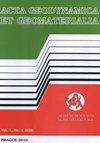The role of the structures on the fluorite mineralization: Insight to fluid inclusion and alteration map of the Laal-kan fluorite deposit, NW Iran
IF 0.8
4区 地球科学
Q4 GEOCHEMISTRY & GEOPHYSICS
引用次数: 2
Abstract
Fluorite mineralization is controlled by the multiple geological processes such as structural control, geochemical characterization of hydrothermal fluids, temperature and depth. The mineralization associated with the alteration of the host rocks and trapping of fluid in the host rock crystallographic defects. Alteration in the host rocks due to circulation of hydrothermal fluids and several techniques were applied to discriminate the associated alterations in fluorite deposition using the ASTER images. The resulting images indicated that the fluorite mineralization in the studied area accompanied by propylitic and phyllic alterations. The results of micro-thermometry analysis of the fluorite hosted fluid inclusions indicated that the maximum homogenization temperature was 253 °C. These data implies that the temperature of hydrothermal fluids probably had an essential role in the propagation of the alteration zones. The depth versus homogenization temperature diagram for fluorite mineralization in the studied district revealed that the depth of fluorite mineralization varies between 33 to 256 m. Two fluorite generations were distinguishing in the study district. The first generation is characterized by high salinity (18-25 wt.% NaCl) which developed on the deeper level and along the fault zone. The second generation is characterized by low salinity (6-13 wt.% NaCl) on shallow depth and deposited in the fractures. The results revealed that fluorite deposition was not contemporaneous with host rock deformation and deposited in the late-stage deformation phase. ARTICLE INFO构造在萤石矿化中的作用——对伊朗西北部Laal-kan萤石矿床流体包裹体和蚀变图的认识
萤石矿化受构造控制、热液地球化学特征、温度和深度等多种地质过程的控制。与寄主岩石的蚀变和寄主岩石晶体缺陷中流体的捕获有关的矿化。利用ASTER图像,应用了热液流体循环引起的主岩蚀变和几种技术来区分萤石沉积中的相关蚀变。由此产生的图像表明,研究区域内的萤石矿化伴随着叶绿质和千枚岩蚀变。含萤石流体包裹体的显微测温分析结果表明,其最高均化温度为253°C。这些数据表明,热液流体的温度可能在蚀变带的扩展中起着重要作用。研究区萤石矿化的深度-均匀化温度图显示,萤石矿化的厚度在33至256米之间。研究区有两代萤石。第一代的特点是高盐度(18-25wt.%NaCl),在更深的水平面和断层带上发育。第二代以浅层低盐度(6-13wt.%NaCl)为特征,沉积在裂缝中。结果表明,萤石沉积与围岩变形不同时,沉积于变形后期。文章信息
本文章由计算机程序翻译,如有差异,请以英文原文为准。
求助全文
约1分钟内获得全文
求助全文
来源期刊

Acta Geodynamica et Geomaterialia
地学-地球化学与地球物理
CiteScore
2.30
自引率
0.00%
发文量
12
期刊介绍:
Acta geodynamica et geomaterialia (AGG) has been published by the Institute of Rock Structures and Mechanics, Czech Academy of Sciences since 2004, formerly known as Acta Montana published from the beginning of sixties till 2003. Approximately 40 articles per year in four issues are published, covering observations related to central Europe and new theoretical developments and interpretations in these disciplines. It is possible to publish occasionally research articles from other regions of the world, only if they present substantial advance in methodological or theoretical development with worldwide impact. The Board of Editors is international in representation.
 求助内容:
求助内容: 应助结果提醒方式:
应助结果提醒方式:


